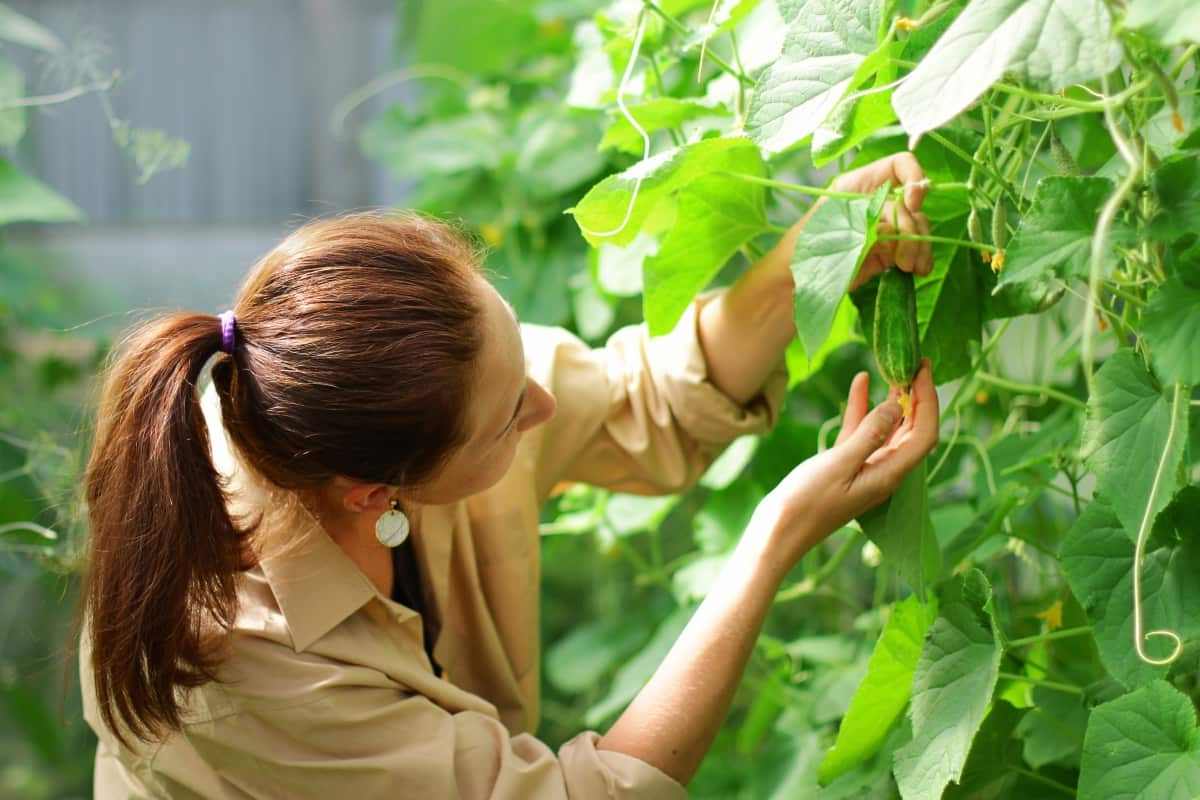Cucumbers are healthy addition to any meal, but unfortunately, they can be plagued by pests that threaten their growth and quality. Cucumber pests can be a big challenge for any gardener or farmer. But keeping your Cucumbers healthy and thriving is possible with the right pest management strategies. Organic and natural treatments are becoming increasingly popular as people become more aware of the harmful effects of synthetic pesticides on themselves and the environment. These methods provide effective control and promote biodiversity in gardens and farms.

How to Identify and Treat Cucumber Pests
Organic Pest Control Methods for Cucumber Plants
Cucumbers are a beloved garden crop, but they can also fall prey to pests that hinder their growth and reduce yields. Fortunately, organic pest control methods can help keep these pesky intruders at bay. One effective method is companion planting. This involves planting certain plants around Cucumbers that repel or deter pests naturally, such as Marigolds for nematodes and Radishes for Cucumber beetles.
Organic sprays made from natural ingredients like neem oil, garlic spray, or hot pepper wax can also work wonders in keeping bugs away without harming beneficial insects like bees and ladybugs. Maintaining healthy soil with proper drainage and composting helps promote vigorous plant growth, making them more resilient against many common Cucumber pests.
Effective Strategies to Prevent Cucumber Beetle Infestation
Cucumber beetles are a common pest that can cause damage to Cucumber plants. These pests feed on the plant’s leaves, stems, and fruits, leading to stunted growth or even death. However, effective strategies can be used to prevent Cucumber beetle infestation. One approach is using row covers over young plants until they begin to flower. This will help protect them from adult beetles while allowing pollinators access once flowers bloom. Another strategy is crop rotation by planting Cucumbers in different areas each year, as this makes it harder for the beetles to find them.
Another option is companion planting with Radishes and Tansy, as these plants repel Cucumber beetles naturally. Handpicking any visible adult or larval forms off the plant when spotted can also help reduce their population. Using insecticidal soap or neem oil sprays has effectively controlled small Cucumber beetle populations without harming beneficial insects like bees and ladybugs. By implementing some of these approaches alone or in combination, you will successfully prevent Cucumber beetle infestations on your Cucumbers.
Natural Remedies for Cucumber Aphid Control
Cucumber aphids are tiny, soft-bodied insects that feed on the sap of Cucumber plants and suck out their vital nutrients. If left unchecked, they can weaken the plant’s immune system and cause significant damage to its leaves and fruits. Fortunately, there are several natural remedies for controlling aphid infestations without resorting to harmful pesticides or chemicals.
One effective method is to use companion planting techniques by growing other plants, such as Marigolds, Dill, or Nasturtiums nearby that emit strong odors that repel aphids. Another natural remedy involves making a homemade insecticidal soap spray using simple ingredients like water, dish soap, and vegetable oil. This solution kills the aphids by suffocating them when sprayed directly on the affected parts of the Cucumber plant.
In case you missed it: How to Increase Female Flowers in Cucumber: Explained in 10 Simple Steps

An alternative approach is releasing beneficial bugs like ladybugs or lacewings into your garden, which act as predators feeding on aphids while maintaining ecological balance. Similarly, you can also try sprinkling diatomaceous earth around your Cucumber plant, which comprises fossilized shells of microscopic algae causing abrasions to an insect’s exoskeleton leading them towards dehydration, eventually resulting in death.
Preventing and Managing Cucumber Downy Mildew
Cucumber downy mildew is a common fungal disease that affects Cucumber plants, causing yellowing and wilting leaves. To prevent an outbreak of this disease in your garden, it’s important to take preventive measures early on. One effective strategy is to ensure proper air circulation around the plants by spacing them out adequately. This can be achieved by pruning dense foliage or using trellises for vertical growth.
Another way to control downy mildew is by avoiding overhead watering, which can create humid conditions favorable for spreading fungus spores. Instead, water at the soil level and use drip irrigation systems where possible. In cases where downy mildew has already affected your plants, consider using organic fungicides like copper sprays or neem oil as natural treatment options.
These remedies should be applied before symptoms appear or soon after their onset for maximum effectiveness. It’s also important to note that preventing Cucumber downy mildew requires consistent monitoring and management throughout the growing season. Regularly inspect your plants for signs of infection, such as yellow spots on leaves, and act promptly with appropriate remedies when necessary.
Controlling Cucumber Mite Infestation in the Garden
Cucumber mites are tiny pests that can cause significant damage to Cucumber plants if left unchecked. They feed on the sap within the leaves, causing them to become yellow and wilted. These pesky creatures thrive in hot and dry conditions, making Cucumbers a prime target during summer. To control Cucumber mite infestations, keeping your garden clean and free of debris is essential.
Remove any infected plant parts immediately and dispose of them properly. This will prevent further spread of the mites. Applying neem oil or insecticidal soap regularly can also help control large populations of Cucumber mites without harming beneficial insects. Ensuring adequate irrigation for your plants helps maintain healthy foliage, which naturally resists pest attacks, including those from Cucumber mites.
Best Practices for Cucumber Whitefly Management
Cucumber whiteflies can be pesky pests that cause significant damage to Cucumber plants. These tiny, winged insects suck the sap out of the leaves and stems of Cucumbers, causing them to wilt and eventually die. To prevent this problem in your garden, following some best practices for Cucumber whitefly management is essential.
You must remove all weeds around your Cucumber plants because they attract and provide a habitat for whiteflies. Ensure proper watering, as overwatering causes high humidity levels that encourage the growth of these pests. You should also watch for ant infestations because ants protect whiteflies from natural predators like ladybugs.
Another effective way to manage Cucumber whitefly populations are using sticky traps or yellow boards coated with petroleum jelly. These traps attract adult insects before they can lay eggs on your plants. You may also want to consider releasing predatory insects like lacewings and parasitic wasps into your garden as another alternative method for combating this type of pest infestation naturally.
Proven Techniques for Preventing Cucumber Powdery Mildew
Cucumber powdery mildew is a fungal disease affecting Cucumber plants, causing leaves to develop powdery white patches. It can stunt plant growth and reduce yields if left unchecked. However, there are proven techniques for preventing this disease from taking hold in your garden. One effective technique for preventing Cucumber powdery mildew is maintaining good air circulation around the plants.
This can be achieved by spacing them out properly and pruning any leaves or stems blocking airflow. Another technique is to avoid overhead watering, which can create conditions favorable for powdery mildew growth. Using organic fungicides such as neem oil or potassium bicarbonate spray has also been shown to prevent and control Cucumber powdery mildew effectively.
In case you missed it: Hydroponic Cucumber Farming in a Greenhouse: Key Rules to Start from Scratch

Applying these treatments early in the season before symptoms appear may help prevent infection altogether. Planting resistant varieties of Cucumbers can be an excellent preventive measure against diseases like powdery mildew. These varieties have been specifically bred to resist certain diseases and pests, making them ideal for sustainable cultivation practices.
Conclusion
Pests can be a real headache for Cucumber farmers. However, with the right pest management strategies, you can effectively control and prevent infestations without harming the environment or your crops. Organic and natural treatments are great options since they do not contain harmful chemicals that could harm both humans and beneficial insects.
Remember to prioritize prevention through good gardening practices such as crop rotation, proper watering techniques, and soil health maintenance. Additionally, keep a watchful eye on your Cucumbers so you can catch any signs of infestation early on. By implementing these simple yet effective pest management strategies for your Cucumber plants, you can enjoy a bountiful harvest of healthy fruits throughout the growing season.
- Ultimate Guide to Ossabaw Island Hog: Breeding, Raising, Diet, and Care
- Ultimate Guide to Juliana Pig: Raising Facts, Size, Diet, Care, and Lifespan
- Raising Lleyn Sheep: Disadvantages, Price, Uses, Characteristics, and Care
- Ultimate Guide to Meishan Pig: Breed Facts, Breeding, Raising, and Care
- Ultimate Guide to Teacup Pigs: Raising, Diet, Lifespan, Cost, and Care
- Guide to Raising Poll Dorset Sheep: Facts, Profile, Characteristics, Uses, and Care
- Ultimate Guide to Bighorn Sheep: Characteristics, Diet, Lifespan, Breeding, and Lifecycle
- Ultimate Guide to Raising Katahdin Sheep: Farming Facts, Breed Profile, Uses, and Care
- Ultimate Guide to Raising Oreo Cows: Belted Galloways Farming Facts, Profile, Uses, and Care